Critique Submissions
This page contains selected November 2001 submissions from photographers who wished to have their photographs reviewed by the publisher of this site,Michael Reichmann, as well as by other readers on ourDiscussion Forum.
The winner this month’s contest and a free issue of theVideo JournalisEric Fredine.
For details on how to submit a photograph for critique please see theCritique / Contestpage.
Eric Fredine

Eric Fredine
Edmonton, Alberta, Canada
efredine@hotmail.com
Taken with a Canon D30, EF 24-85mm @ 24mm, 1/45 @ f/13, cropped for a better composition, modest levels and curves adjustments applied.
My attempt at a unique view of a Canadian icon: Lake Louise. Taken in the early morning when the sky was overcast with shifting light. The shaft of light on the right was only there for a few minutes.
Michael’s Critique
Sometimes I open a submission and am knocked back in my chair. What a stunning image. Everything works. There’s balance, drama and a strong graphic component. Of course the sunlight shaft is what makes it sing, and sing it does. Location and timing done to perfection.
You can add your own comments on Eric’s photograph on the Critique section of ourDiscussion Forum.
Nancy Patrick
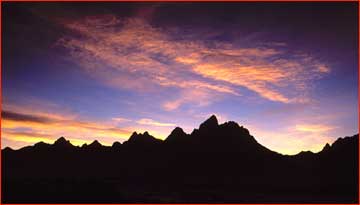
Nancy Patrick
Casper, Wyoming
nancypa@trib.com
Contax Aria, 35-70mm, Provia 100F Exposure 1/15 sec @ F9.5 Manfrotto 3021 Tripod
While on my way to attend a business conference in Jackson Hole, Wyoming I arrived at Snake River Overlook in Grand Teton National Park with ample time to set up and wait for sunset. As I watched the clouds just kept building with a most interesting pattern. The Tetons rise a mile and a half above their base. This creates a very narrow time and positional window in which the sun’s rays bathe the clouds in apline glow before setting. Fortunately I had the opportunity to be there to capture that fleeting moment.
Michael’s Critique
Well executed, but not unique. We’ve all shot this type of scene when working in the mountains, and Nancy has pulled it off nicely. But we should all feel challenged to try and find new ways of capturing this type of appealing image. Otherwise we just end up copying ourselves endlessly.
You can add your own comments on Nancy’s photograph on the Critique section of ourDiscussion Forum.
Horst R ‚œdding
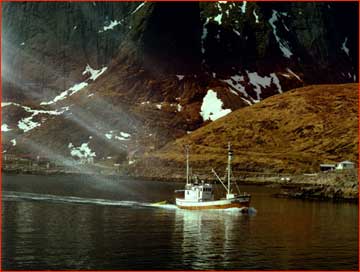
Horst R ‚œdding
M ‚œdling, Austria
h.roedding@kabsi.at
Hasselblad 500 EL/M, Tele Tessar 5,6 / 350 mm, Kodak VPS, Imacon Flextight Photo, Photoshop 5,5
I took it in 1985 in Norway at the Lofoten islands
Michael’s Critique
What immediately grabbed me in this photograph was the shafts of light and their contrast with the black water and cliffs. It really raises this image above the ordinary.
You can add your own comments on Horst’s photograph on the Critique section of ourDiscussion Forum.
Tim Gray
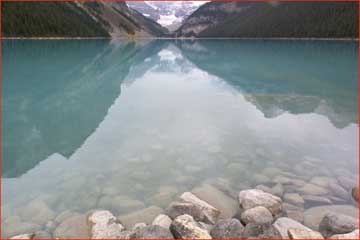
Tim Gray
Toronto Ontario Canada
timgray@sympatico.ca Canon D30 Digital 1/30 F22 ISO 200 Sigma 14mm. Lake Louise, Banff National Park. By the time we got to Lake Louise from Calgary the clouds had really dropped in, so I shot the lake. Focus manually set at 2′, the hyperfocal distance for this focal length.
Michael’s Critique
This image has bold framing as well as a fascinating contrast between the soft pastel colours at the bottom and the strong contrast at the top of frame. Very well seen.
You can add your own comments on Tim’s photograph on the Critique section of ourDiscussion Forum.
Collin Orthner
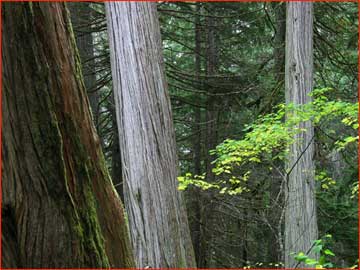
Collin Orthner Red Deer, Canadacorthner@shaw.ca Canon G2 digital camera with a polarizer on a tripod. This image of giant cedars was made a couple of weeks ago in Revelstoke National Park, British Columbia.
Michael’s Critique
I usually don’t comment on image resolution as part of this critique section, largely because when reproduced at these sizes and at 72dpi it doesn’t make much difference. This is a well seen image, but when I saw that it was produced with a 4MP digital camera it struck me that even without seeing a good original print I would be disappointed. I’m not singling out the Canon G2, a fine digital P&S. This is the kind of image that anything short of medium format simply can’t do justice to. Not a criticism. Just an observation.
You can add your own comments on Collin’s photograph on the Critique section of ourDiscussion Forum.
Daniel Rice
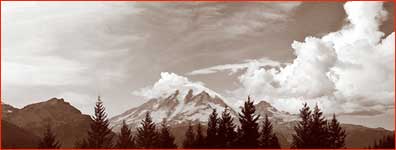
Daniel Rice
Olympia, WA USA
Canon Powershot S10
I took many images of Mt. Rainier from a viewpoint at the south east corner of the park. Then I stitched together these two images with C anon Photostitch. In Photoshop, I sepia toned the image.
Michael’s Critique
When I receive submissions the first thing I do is look at the image. Only afterward, when I’ve made a judgment of whether or not I’ll publish it, and what I think about it, do I read the accompany text and technical data. I was very pleased to see that this very well done mountain and cloudscape was created with a digital P&S. It just goes to show that a good eye and technique are always more important than hardware.
As to the composition itself, I would crop the framelike this. I feel that the composition peters-out after the leftmost tree.
You can add your own comments on Daniel’s photograph on the Critique section of ourDiscussion Forum.
Pedro Lastra
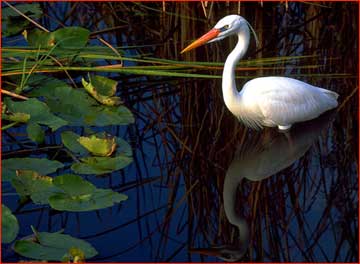
Pedro Lastra
Coral Gables, FL
plastra@temgweb.com
Leica R-8, 80-200 F4, taken at 1/500 at f5.6 on Provia
I took this Great Blue Heron, White Morph, last winter in the Anhinga trail at the Everglades N.P. As soon as the cold weather hits the northern latitudes, migratory birds congregate in southern Florida to pass the winter. This is a wonderful time to observe and photograph colorful birds.
Michael’s Critique
What a lovely image! I’m particularly taken with the subtle reflection of the bird and background trees in the dark water. The dark saturated leaves at left of frame are also an excellent complement to the white bird.
I find the stalks behind the bird’s head somewhat distracting though, and if I were working on this image in Photoshop I’d have taken the liberty of removing them.
You can add your own comments on Pedro’s photograph on the Critique section of ourDiscussion Forum.
David Mantripp
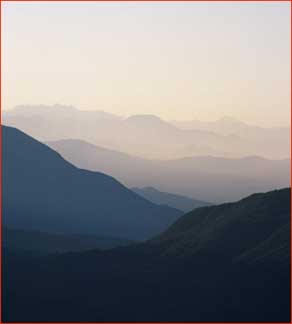
David Mantripp
Lugano, Switzerland
david.mantripp@bluewin.ch
Canon A1, Tamron 28-200mm , Fuji Provia 100F , Scanned at 4000ddpi on Microtek ArtixScan 4000t , cropped in Photoshop
This one is close to home – about half an hour’s walk from my front door in fact. A very photogenic area, at first glance, but in fact very difficult to capture on film. This was taken one August evening looking towards the Southern Swiss Alps from Mt San Salvatore, near Lugano, Switzerland. The glow from the sun reflecting off the mist in the mid-distance really lifts this photograph for me. One of my personal favourites, I think, for this year.
Michael’s Critique
There are a couple of things that get in the way of this being a totally successful image. The first of them is the cropping. There’s far too much sky that lacks any contribution to the image, and there’s too much black at the bottom.HereI show an alternative cropping that I feel improves the composition considerably.
Secondly, while these "layered landscapes" always have the makings for fine photographs, in this case there isn’t anything else to satisfy the eye. Once I’ve seen it, there’s nowhere else for my eye to go. To be a stronger image it needs either a foreground element or a more compelling sky.
You can add your own comments on David’s photograph on the Critique section of ourDiscussion Forum.
Chris VenHaus

Chris VenHaus
Waukesha WI USA
drmr@execpc.com
Canon A2E, Canon 24mm f2.8, Fuji Superia 800
I took this image after the moon set during the Oct. 28th. geomagnetic storm. I have been trying to get a shot like this for over a year and a half with no luck. I have other shots with more foreground interest, but I like the abstract nature of the shadowed shoreline with the reflection in the lake, and the brilliant colors of the aurora. The hardest part about getting this shot was finding a suitable location with a dark sky, and decent composition. I found this spot over 3 hour (1-way) drive from my home, after many, many road trips searching…. This night was relatively windy, so my regular spot wasn’t suitable on the other side of the lake, so I came over to this side, where the calmer water would allow for reflections. Link to larger image: http://venhaus1.com/auroragallery.html
Michael’s Critique
Being at the right place at the right time. Then, chasing the opportunity and having the skill and equipment to carry it off. The ingredients for an effective photographs. It’s all worth the effort when it produces a unique image such as this one.
You can add your own comments on Chris’ photograph on the Critique section of ourDiscussion Forum.
Dave Muoio
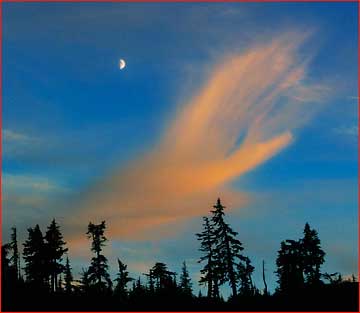
Dave Muoio
Issaquah, WA USA
dave@gruntled.com
Canon D30, ISO 400, EF 28-70 2.8L
Taken near Mt. Shuksan in Washington. This cloud formation developed away from my subject area and I quickly took a picture of it as the light was fading fast. I wish I had more time. This is a huge crop from the original image because I saw the "right composition" after the fact. Used levels and curves adjustment for initial color balance. Added Gaussian blur overly in the sky to intensify the color as well as smooth the transitions. Used slight unsharp mask to the trees.
Michael’s Critique
There are a lot of interesting ingredients here. The silhouetted trees, the moon, the deep blue sky; but I find the cloud most intriguing. It looks so much like an open hand reaching out. For this reason, and to balance the composition a bit I suggestan alternative cropping.
You can add your own comments on Dave’s photograph on the Critique section of ourDiscussion Forum.
Doug Dolde
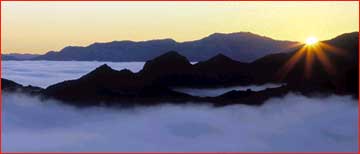
Doug Dolde Thousand Oaks California Mamiya 7II, 65mm lens, Fuji Velvia Sea of clouds filling the valley shot at sunup in the Santa Monica mountain range the day after our first rain in over six months. Only a half hour or less from all the nasty stuff in Los Angeles. Highly cropped from the original 6×7. Larger version posted athttp://www.zumirez.com/kanan_01_large.jpg
Michael’s Critique
The starburst of the sun is a fortuitous element. Without it, the clear sky would have diminished an otherwise strong composition. Excellent timing.
You can add your own comments on Doug’s photograph on the Critique section of ourDiscussion Forum.
Tom Applegate
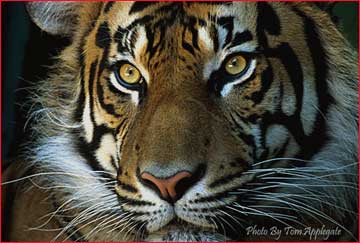
Tom Applegate Santa Cruz, CA, USAtdapplegate@sbcglobal.net Camera: Canon EOS 1v.
Lens: Canon 500mm f4 IS with x2 extender, = 1000mm at around f8. Film: Fuji Provia 400F. Scanner: Nikon LS-2000. I went to Sacramento California with my wife, she was on a business trip, and we stayed the night. The next morning while she went to her meeting, I went to the Sacramento zoo. I have been trying to get pictures of captive animals that donÃt look captive in the photographs and when I got to the zoo and ran to the area of the Somalian Tigers, you guest it, they were already fed and laying down. Around noontime I started back to my car and decided to go back to see if they were moving around and happy days. They were playing games and chasing each other around. I set up my tripod and camera and burned up two rolls of film. This shot is 1 out of 72. It happened when some little kid screamed and that got his attention.Michael’s Critique
Zoo photograph offers wonderful opportunities to practice ones wildlife shooting skills. Tom’s tiger is stunning in its intensity. I particularly like how the frame is tightly cropped, adding a strong feeling of menace.
You can add your own comments on Tom’s photograph on the Critique section of ourDiscussion Forum.
Don Weston
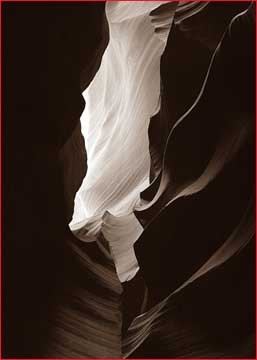
Don Weston
Wethersfield CT
This is a shot I took in Page, AZ. It was shot on a Linhof SuperTech 4×5 with a Nikor 210Wlens on Velvia Readyload film. The transparency was scanned on an Epson 1200U scanner and then converted to mono and toned. It was tweaked for tone and contrast and sized. I have tried it as a horizontal also, but feel it works best as a vertical format.
Michael’s Critique
While photographs from Antelope Canyon have become something of a clichÈ in contemporary landscape photography of the American Southwest, Don’s image nicely captures the shapes and tonalities found there. The monochromatic treatment is also a welcome change from the over-saturated colours usually seen.
You can add your own comments on Don’s photograph on the Critique section of ourDiscussion Forum.
Monique Vanstone
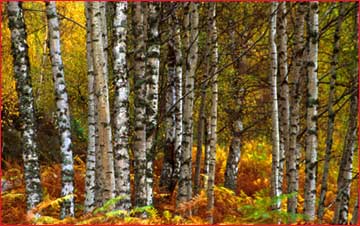
Monique Vanstone Poole UKmonik@ukonline.co.uk Silver beech trunks photographed in the Highlands of Scotland end of October 2001. Nikon F90X, zoom 70-210 at about 150mm, f16, Velvia, tripod, Nikon Coolscan III, slight adjustment in Photoshop 5 LE, for levels and saturation.
Michael’s Critique
Nature is inherently messy, and the job of the landscape photographer is to extract the essence of a scene from the jumble that usually assaults our eyes. In this case Monique has embraced the mess and come away with a strong image. The contrast between the monochrome birches and the over-saturated fall colours is a large part of the appeal.
You can add your own comments on Monique’s photograph on the Critique section of ourDiscussion Forum.
Andrzej Poniatowski
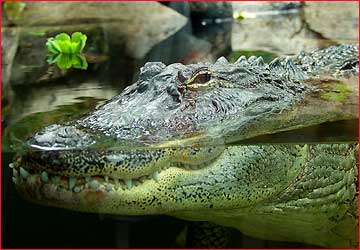
Andrzej Poniatowski Ornskoldsvik, Sweden Camera: Olympus E-10 Location: Teneriffe (Canary Islands), Loro-Zoo, March 2001 Some minor editing done in Photoshop. One wishes to be able to come that close in "real life" situation – thanks God we have zoos!
Michael’s Critique
This is a very appealing image. I first saw the classic "above the water-line" croc profile. But then, almost as if it was an optical illusion, I see the underwater half. Spooky. Well seen and executed.
You can add your own comments on Andrzej’s photograph on the Critique section of ourDiscussion Forum.
Jerry Arnold
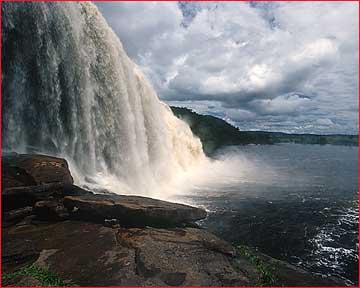
Jerry Arnold Rockledge, Floridajarnold@seewhatwesee.com Nikon N-90S, 17-35 Nikor lens, Kodak VC-100 slide film Traveling in Venezuela last year I had the opportunity to fly into Canaima National Park in the southern portion of the country, very near the Amazon. Accessible only by plane or a three day journey by boat, the area is incredibly pristine and beautiful. My wife and I traveled across the lagoon by dugout canoe and were left off at the far side of the falls. We proceeded to walkunderneath the fallsemerging on the beautiful red Jasper rock outcropping. Difficult to see in the image is the color of the water, stained the color of a well-brewed tea by the tanin from decaying plant material. Were it not for the reflection of the sky, its color would more nearly match the rocks.
Michael’s Critique
It is unusual to be able to get this close to the base of such a grand waterfall. I don’t find that the rock outcropping helps the composition. It’s my sense that the waterfall and the cloud-filled sky would be all that’s needed, shot from a closer perspective, if that was possible.
You can add your own comments on Jerry’s photograph on the Critique section of ourDiscussion Forum.
Jeff Krewson
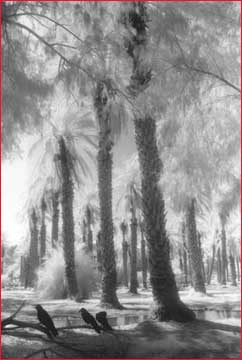
Jeff Krewson
Bellevue, Washington, USA
jeffree@jeffkrewson.com
www.jeffkrewson.com
Link to slightly larger image: http://www.jeffkrewson.com/F_Ravens.jpg
Pentax Program Plus 35mm camera, Tokina 35-135mm lens, Kodak High Speed Infrared film with #25 red filter, traditional development and printing. Photo was taken in Death Valley, California on a sweltering midsummer afternoon as the ravens were resting in the shade. The open mouthed one was panting it was so hot. Took the shot without getting out of my car for fear of spooking the little critters. Was really hoping to have a memorable shot as the palm trees were looking awfully lush. This was the last of five frames I exposed at the spot. It’s one of my all-time favorites.
Michael’s Critique
I can understand why this is one of Jeff’s favourites. As you’ll see if you go to the link containing his larger version, it’s a very captivating image. Compositionally my only critique would be that the clear sky on the left is a little distracting. It would have been a more intense composition of it could have been taken from a spot just a few feet further to the left.
You can add your own comments on Jeff’s photograph on the Critique section of ourDiscussion Forum.
Miles Hecker
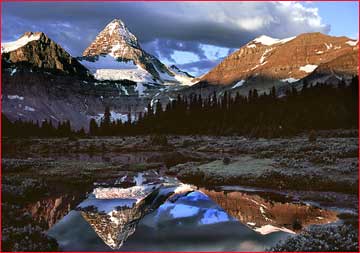
Mt Assiniboine provincal park, British Columbia
Miles Hecker
Casper, Wyoming
mhecker@acad.cc.whecn.edu
Contax Aria, 35-70mm Zeiss lens, Provia 100F, exposure 1/60 sec @ f 8.0, 2 stop split-neutral density filter applied in Photoshop Mt Assiniboine is often called the Matterhorn of the rockies. This majestic peak is 13 miles in from the nearest trailhead. Most summers it is socked in for days at a time by the rains that frequent that part of the Canadian rockies On the fourth morning that we attempted a sunrise shot the weather broke. I found a small pool which provided an interesting forground reflection and obtained this pleasing image.
Michael’s Critique
I have mixed feelings out this image. There’s strength to all of the components, but…
My first concern is that the mountain’s reflected image in the lake is cropped too close to the edge of frame. It needs a bit more breathing room. Secondly, the deep shadows of the foreground don’t add anything, and yet I feel like I want to strain to look into them for detail. Finally, the clouds are lumpy and therefore they don’t compliment the rest of the composition.
You can add your own comments on Miles’ photograph on the Critique section of ourDiscussion Forum.
Greg Goodman
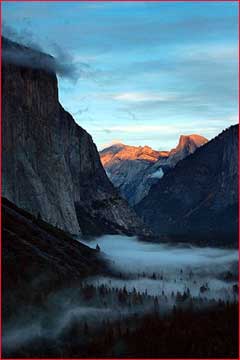
Greg Goodman Tustin, CA USA Canon D30, 28-135 IS USM lens, Graduated Neutral Density filter, Exposure 1/4 sec @ f13, Gitzo Explorer Tripod, Photoshop 6.0 (mild levels and curves), Nik Sharpener Pro I know this is a very mature subject (Tunnel View of Yosemite Valley). However it is the most dramatic photo from our trip to Yosemite during this last Veterans Day holiday. You can find a larger version (as well as other photos from the trip) at the following URL:
Michael’s Critique
Anyone familiar with Yosemite will know exactly where this photograph was taken from. As Greg says, it’s been done before, but in this case with a strong vision and good technique. The fog in the valley combined with the cloud sliding off the rock face is particularly appealing. One almost has the sense that it’s flowing down the mountain to fill the valley floor.
You can add your own comments on Greg’s photograph on the Critique section of ourDiscussion Forum.
Douglas Herr
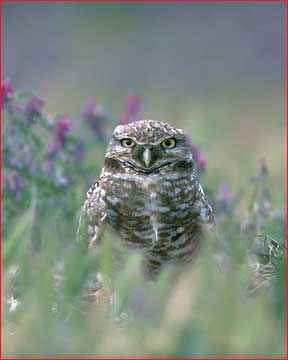
Douglas Herr
Sacramento California, USA
telyt@earthlink.net
Leica reflex camera, 400mm f/6.8 lens, Kodachrome 64 film.
The bird is a Burrowing Owl, which is often active in daylight.
Michael’s Critique
Eye contact with wildlife, just as in the portrait of a person, is a compelling element. I also particularly like the four separate planes of focus‚ the foreground, the owl, the flowers directly behind it and then the very out-of-focus background. They help make this head-on view have an unusual element of dimensionality often missing from shots with such a long lens. The "bokeh", or nature of the out-of-focus areas is very appealing, likely an aspect of the use of a Leica lens, which typically have appealing blur.
You can add your own comments on Doug’s photograph on the Critique section of ourDiscussion Forum.
All Photographs on This Page are the Copyright of Their Respective Photographers
All Rights are Reserved
You May Also Enjoy...
Uniqball Review
Uniqball - a Unique Approach to Levelling by Nick Devlin @onelittlecamera In1974, Ernő Rubik invented the Rubik’s Cube. A generation of us grew up twisting
